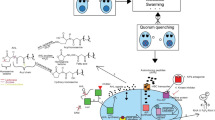Abstract
The synthesis of superoxide dismutase [SOD: EC 1.15.1.1] in response to various cultural conditions was examined in Candida albicans, an opportunistic yeast which causes candidiasis in immunosuppressed patients. SOD plays an important role in protecting cells from the oxidative damage of superoxide radicals. Maximum SOD activity was found after 72 hrs of yeast growth. The optimum pH and temperature for the SOD activity were 7 and 40 °, respectively. The major SOD activity was found in the cytosol fraction and the level of extracellular SOD was very low. The enzyme was stimulated to varying degrees by cholic acid, procaine and tocopherol. On the basis of inhibitor studies and other enzyme properties, the isolated enzyme from C. albicans is identified as copper and zinc superoxide dismutase.
Similar content being viewed by others
Author information
Authors and Affiliations
Rights and permissions
About this article
Cite this article
Gunasekaran, U., Yang, R. & Gunasekaran, M. Regulation of superoxide dismutase synthesis in Candida albicans. Mycopathologia 141, 59–63 (1998). https://doi.org/10.1023/A:1006985710874
Issue Date:
DOI: https://doi.org/10.1023/A:1006985710874




